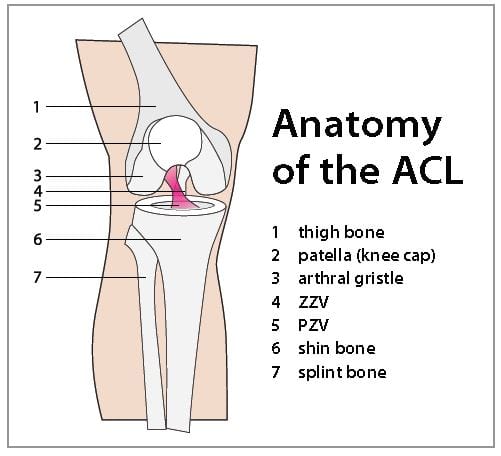The ABCs of ACLs – Sports Injuries Are Common in This Knee Ligament
An ACL injury is the tearing of the anterior cruciate ligament (ACL), one of four major ligaments in the knee. Ligaments are strong bands of tissue that connect one bone to another. The ACL ligament limits the amount of rotation that can occur between the femur and tibia, the two long bones that form the knee joint.
ACL injuries most commonly occur during sports that involve sudden stops, landing from a jump, or rapid changes in direction — such as basketball, soccer, football, tennis, downhill skiing, ultimate Frisbee, and gymnastics.
Most ACL injuries happen during sports and vigorous activities that can put stress on the knee, such as pivoting with the foot firmly planted, landing from a jump incorrectly, suddenly slowing down and changing direction (cutting) or stopping suddenly, or receiving a direct blow to the knee, such as a football tackle.
Many people hear or feel a ‘pop’ in the knee when an ACL injury occurs. It may feel like your knee ‘gives way’ or ‘gives out.’ Your knee may swell, feel unstable, and become too painful to bear weight. Often, people will need to use crutches for a few days. When the ligament is damaged, there is usually a partial or complete tear across the tissue. A mild injury may stretch the ligament but leave it intact.
Besides that loud popping sensation, signs and symptoms of an ACL injury usually include severe pain and inability to continue activity, swelling that begins within a few hours and worsening 24 hours later, inability to completely straighten the knee or bend it greater than 90 degrees, and a feeling of instability with weight bearing.
Seek immediate care if any injury to your knee causes signs or symptoms of an ACL injury. The knee joint is a complex structure of bones, ligaments, tendons and menisci that work together. It’s important to get a prompt and accurate diagnosis to determine the severity of the injury and get proper treatment.
About 70{06cf2b9696b159f874511d23dbc893eb1ac83014175ed30550cfff22781411e5} of ACL injuries occur through non-contact mechanisms, while 30{06cf2b9696b159f874511d23dbc893eb1ac83014175ed30550cfff22781411e5} result from direct contact with another player or object. The mechanism of injury is often associated with deceleration coupled with cutting, pivoting, or sidestepping maneuvers. Many injuries occur from an off-balance landing on one leg, or from a high-speed, out-of-control play.
Females are five to six times more likely to have an ACL injury than males who participate in the same sport. Studies have shown this increased risk for females may be due to differences in physical conditioning, muscular strength, and neuromuscular control with jumping and landing.
Other causes of this gender-related difference in ACL injury rates include pelvic width, hip and knee alignment, increased ligamentous laxity, and the effects of estrogen on ligament properties. Studies comparing jumping and landing techniques among male and female athletes have shown that female athletes are more likely to land from a jump in a way that increases stress on their knees. Research also indicates that specific training to strengthen muscles of the legs, hips and core — as well as training to improve jumping and landing techniques — may reduce the higher ACL injury risk associated with female athletes. The Sportsmetrics jump-training program was designed specifically to reduce this risk.
On the Mend
Prompt action can reduce pain and swelling immediately after an injury to the knee. Follow the RICE model of self care at home:
• Rest. General rest is necessary for healing and limits weightbearing on the knee.
• Ice. When you’re awake, try to ice your knee at least every two hours for 20 minutes at a time.
• Compression. Wrap an elastic bandage, compression sleeve, or compression wrap around your knee.
• Elevation. Lie down flat and prop up your leg so the foot and knee are higher than the heart.
Medical treatment for an ACL injury begins with several weeks of physical therapy. A physical therapist will teach you how to do exercises that you will perform either with continued supervision or at home. You may also wear a brace to stabilize your knee and use crutches for three to five days to avoid putting full weight on the knee.
The goal of rehabilitation is to reduce pain and swelling, restore the knee’s full range of motion, and strengthen muscles. This course of physical therapy may successfully treat an ACL injury for individuals who are relatively inactive, engage in moderate exercise and recreational activities, or play sports that put less stress on the knees.
Your doctor may recommend surgery for one of several reasons: if you’re an athlete and want to continue in your sport, especially if the sport involves jumping, cutting, or pivoting; if more than one ligament or the cartilage in the knee is injured; or if the injury is causing the knee to buckle during everyday activities.
Unfortunately, your surgeon cannot use a suture to sew your ACL back together. Attempts to do this in the past have resulted in ligament failure within a year. There is a new technique, using a sponge-like material, that aims to successfully sew the ligament back together, but human trials have only just begun.
For now, the only successful outcome is to replace the ligament. During ACL reconstruction, the surgeon removes the damaged ligament and replaces it with a segment of tendon — tissue similar to a ligament that connects muscle to bone. This replacement tissue is called a graft. Your surgeon will use a piece of tendon from another part of your leg or a tendon from a donor. The graft will serve as scaffolding on which new ligament tissue can grow.
Grafts commonly used to replace the ACL include patellar tendon graft, hamstring tendon graft, quadriceps tendon graft, or allograft (taken from a donor) of the patellar tendon, Achilles tendon, or hamstring tendon.
After surgery, you’ll resume another course of physical therapy. Successful ACL reconstruction paired with rigorous rehabilitation can usually restore stability and function to the knee. Athletes often can return to their sports after eight to 12 months. Patients treated with surgical reconstruction of the ACL have long-term success rates of 82{06cf2b9696b159f874511d23dbc893eb1ac83014175ed30550cfff22781411e5} to 95{06cf2b9696b159f874511d23dbc893eb1ac83014175ed30550cfff22781411e5}. Graft failure is seen in only 8{06cf2b9696b159f874511d23dbc893eb1ac83014175ed30550cfff22781411e5} of patients.
Preventive Measures
Proper training and exercise can help reduce the risk of ACL injury. A physical therapist, athletic trainer, or sports-medicine specialist can provide assessment, instruction, and feedback to help you reduce your risk.
Programs to reduce ACL injury include exercises that strengthen leg muscles, particularly quadriceps and hip rotators; exercises to strengthen and activate the core muscles during motion; training and exercise for proper techniques and knee position in jumping and landing; and training to improve technique and tissue resilience for pivoting and cutting.




Comments are closed.